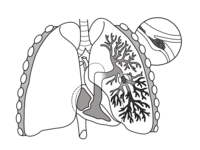
Photo from wikipedia
Previous studies have shown an incidence of saddle pulmonary embolism (SPE) ranging between 6% to 9.1% in non-high-risk patients [1,2]. SPE is generally defined as a thromboembolus straddling the bifurcation… Click to show full abstract
Previous studies have shown an incidence of saddle pulmonary embolism (SPE) ranging between 6% to 9.1% in non-high-risk patients [1,2]. SPE is generally defined as a thromboembolus straddling the bifurcation of themain pulmonary artery trunk. Conversely, central PE is diagnosed when thrombi are visualized at computed tomography angiography (CTA) in the main trunk and/or in right or left main pulmonary arteries [3]. Its real epidemiology has not yet been assessed since, very frequently, the diagnosis is established at autopsy. As matter of fact, different studies have included SPE patients into themore general group of “central embolism”, confounding the final results [1]. As results, available data regarding the short-term outcome of SPE patients are scant and controversial. Generally, a saddle embolus is indicative of a large unstable clot burden in the pulmonary circulation associated with a higher risk of sudden hemodynamic collapse [4]. Nowadays, several uncertainties remain regarding the optimal management of these subjects, especially those who were hemodynamically stable at admission. Furthermore, latest international guidelines on the management of acute PE have no considered SPE, leaving this issue in a “no guidelines land” [5]. A wide debate on the most appropriate approach to SPE patient, hinges on the higher risk of acute right ventricular failure/dysfunction (RVD) and the possible sudden hemodynamic deterioration of these patients has been opened over the last years. Although the stratification of severity of PE is currently based on the hemodynamic status and the evaluation of myocardial injury/ dysfunction markers, the burden of emboli and their localization in the pulmonary arterial tree still represents a prognostic tool in hemodynamically stable PE patients. Indeed, hemodynamic deterioration in these subjects is not only a “matter of RVD”, since the significant thrombotic burden can significantly decrease the pulmonary blood flow determining serious hemodynamic effects, also mediated by subsequent neurohormonal activation [6]. Previous studies and meta-analyses have demonstrated that the localization of emboli is a predictor of short-term survival. In fact, it seems that, rather than saddle emboli, central emboli are associated with a two-fold risk of poorer outcome in hemodynamically stable patients [7]. These results have been confirmed by a meta-analysis conducted by Vedovati et al. which showed that hemodynamically stable patients with central emboli had a higher risk of death when compared to those with a more distal embolization [8]. Previous
Journal Title: European journal of internal medicine
Year Published: 2017
Link to full text (if available)
Share on Social Media: Sign Up to like & get
recommendations!